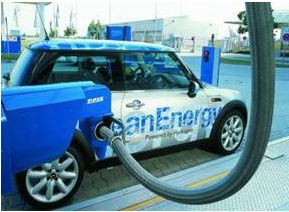Home > Press > New material could speed development of hydrogen powered vehicles
 |
| Researchers have designed a material made of graphene sheets for hydrogen storage that could advance development of hydrogen powered vehicles. Credit: Oak Ridge National Laboratory |
Abstract:
Researchers in Greece report design of a new material that almost meets the U.S. Department of Energy (DOE) 2010 goals for hydrogen storage and could help eliminate a key roadblock to practical hydrogen-powered vehicles. Their study on a way of safely storing hydrogen, an explosive gas, is scheduled for the Oct. 8 issue of ACS' Nano Letters, a monthly journal.
New material could speed development of hydrogen powered vehicles
Crete, Greece | Posted on October 1st, 2008Georgios K. Dimitrakakis, Emmanuel Tylianakis, and George E. Froudakis note that researchers long have sought ways of using carbon nanotubes (CNTs) to store hydrogen in fuel cell vehicles. CNTs are minute cylinders of carbon about 50,000 times thinner than the width of a human hair. Scientists hope to use CNTs as miniature storage tanks for hydrogen in the coming generation of fuel cell vehicles.
In the new study, the researchers used computer modeling to design a unique hydrogen-storage structure consisting of parallel graphene sheets — layers of carbon just one atom thick —stabilized by vertical columns of CNTs. They also added lithium ions to the material's design to enhance its storage capacity. The scientists' calculations showed that their so-called "pillared graphene" could theoretically store up to 41 grams of hydrogen per liter, almost matching the DOE's target (45 grams of hydrogen per liter) for transportation applications. "Experimentalists are challenged to fabricate this material and validate its storage capacity," the researchers note. — MTS
####
For more information, please click here
Contacts:
George E. Froudakis, Ph.D.
University of Crete
Heraklion, Crete
Greece
Phone: 30-2810545055
Fax: 30-281545001
Copyright © American Chemical Society (ACS)
If you have a comment, please Contact us.Issuers of news releases, not 7th Wave, Inc. or Nanotechnology Now, are solely responsible for the accuracy of the content.
| Related News Press |
News and information
![]() Simulating magnetization in a Heisenberg quantum spin chain April 5th, 2024
Simulating magnetization in a Heisenberg quantum spin chain April 5th, 2024
![]() NRL charters Navy’s quantum inertial navigation path to reduce drift April 5th, 2024
NRL charters Navy’s quantum inertial navigation path to reduce drift April 5th, 2024
![]() Discovery points path to flash-like memory for storing qubits: Rice find could hasten development of nonvolatile quantum memory April 5th, 2024
Discovery points path to flash-like memory for storing qubits: Rice find could hasten development of nonvolatile quantum memory April 5th, 2024
Discoveries
![]() Chemical reactions can scramble quantum information as well as black holes April 5th, 2024
Chemical reactions can scramble quantum information as well as black holes April 5th, 2024
![]() New micromaterial releases nanoparticles that selectively destroy cancer cells April 5th, 2024
New micromaterial releases nanoparticles that selectively destroy cancer cells April 5th, 2024
![]() Utilizing palladium for addressing contact issues of buried oxide thin film transistors April 5th, 2024
Utilizing palladium for addressing contact issues of buried oxide thin film transistors April 5th, 2024
Announcements
![]() NRL charters Navy’s quantum inertial navigation path to reduce drift April 5th, 2024
NRL charters Navy’s quantum inertial navigation path to reduce drift April 5th, 2024
![]() Discovery points path to flash-like memory for storing qubits: Rice find could hasten development of nonvolatile quantum memory April 5th, 2024
Discovery points path to flash-like memory for storing qubits: Rice find could hasten development of nonvolatile quantum memory April 5th, 2024
Energy
![]() Development of zinc oxide nanopagoda array photoelectrode: photoelectrochemical water-splitting hydrogen production January 12th, 2024
Development of zinc oxide nanopagoda array photoelectrode: photoelectrochemical water-splitting hydrogen production January 12th, 2024
![]() Shedding light on unique conduction mechanisms in a new type of perovskite oxide November 17th, 2023
Shedding light on unique conduction mechanisms in a new type of perovskite oxide November 17th, 2023
![]() Inverted perovskite solar cell breaks 25% efficiency record: Researchers improve cell efficiency using a combination of molecules to address different November 17th, 2023
Inverted perovskite solar cell breaks 25% efficiency record: Researchers improve cell efficiency using a combination of molecules to address different November 17th, 2023
![]() The efficient perovskite cells with a structured anti-reflective layer – another step towards commercialization on a wider scale October 6th, 2023
The efficient perovskite cells with a structured anti-reflective layer – another step towards commercialization on a wider scale October 6th, 2023
Automotive/Transportation
![]() Researchers’ approach may protect quantum computers from attacks March 8th, 2024
Researchers’ approach may protect quantum computers from attacks March 8th, 2024
![]() Tests find no free-standing nanotubes released from tire tread wear September 8th, 2023
Tests find no free-standing nanotubes released from tire tread wear September 8th, 2023
Fuel Cells
![]() Current and Future Developments in Nanomaterials and Carbon Nanotubes: Applications of Nanomaterials in Energy Storage and Electronics October 28th, 2022
Current and Future Developments in Nanomaterials and Carbon Nanotubes: Applications of Nanomaterials in Energy Storage and Electronics October 28th, 2022
|
|
||
|
|
||
| The latest news from around the world, FREE | ||
|
|
||
|
|
||
| Premium Products | ||
|
|
||
|
Only the news you want to read!
Learn More |
||
|
|
||
|
Full-service, expert consulting
Learn More |
||
|
|
||








